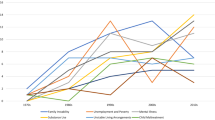Abstract
Demand for supportive housing outstrips availability in metropolitan regions around the country. Individuals who are homeless with serious mental illnesses, substance abuse, and other debilitating health conditions are often heavy users of publicly financed services and institutions, such as jails, emergency departments, psychiatric and medical hospitals, and sobering and detoxification services. King County, in collaboration with community partners, has developed a regional system for coordinating and prioritizing access to this limited resource based on utilization of publicly financed services/institutions and/or vulnerability. In this paper, the model, key implementation steps, preliminary results, and lessons learned are described.
Similar content being viewed by others
References
National Alliance to End Homelessness. The State of Homelessness in America 2015. National Alliance to End Homelessness. Available online at http://www.endhomelessness.org/library/entry/the-state-of-homelessness-in-america-2015. Published April 1, 2015. Accessed May 6, 2015
Culhane DB, Byrne T. Ending chronic homelessness: Cost‐effective opportunities for interagency collaboration. Penn School of Social Policy and Practice. Selected Works of Dennis P. Culhane. Available online at http://works.bepress.com/dennis_culhane/94/. Published March, 2010. Accessed April 28, 2015
Flaming D, Matsunaga M, Burns P. Where we sleep: Costs when homeless and housed in Los Angeles. LA: Economic Roundtable. Available online at http://economicrt.org/publication/where-we-sleep/. Published November 1, 2009. Accessed April 28, 2015.
Larimar M, Malone D. Health care and public service use and costs before and after provision of housing for chronically homeless persons with severe alcohol problems. JAMA 2009;301(13), 1349-1357.
Srebnik D, Connor T, Sylla L. A pilot study of the impact of housing first-supported housing for intensive users of medical hospitalization and sobering services. American Journal of Public Health 2013; 103:316-321
Housing and Urban Development. Homeless Emergency Assistance and Rapid Transition to Housing: Continuum of Care Program – Interim Rule 24 CFR Part 578, July 31, 2012
Malone D. Assessing criminal history as a predictor of future housing success for homeless adults with behavioral health disorders. Psychiatric Services, 2009; 60:224-230.
Flaming D, Burns P, Sumner G, et al. Crisis Indicator: Triage tool for identifying homeless adults in crisis. The Conrad N. Hilton Foundation, Corporation for Supportive Housing. Economic Roundtable. Available online at http://economicrt.org/publication/crisis-indicator/ Published August 1, 2011. Accessed May 6, 2015.
Poulin S, Maguire J, Mettraux S, et al. Service use and costs for persons experiencing chronic homelessness in Philadelphia: A population-based study. Psychiatric Services. 2010; 61:1093-1098.
Fazel S, Khosla V, Doll H, et al. The prevalence of mental disorders among the homeless in western countries: Systematic review and meta-regression analysis. PLOS Medicine, 2008; 5(12); e225. doi: 10.1371/journal.pmed.0050225
Culhane D, Mertraux S, Hadley T. Public service reductions associated with placement of homeless persons with severe mental illness in supportive housing. Housing Policy Debates, 2002; 13(1): 107-163.
Flaming D, Burns P, Sumner G, et al. Hospital to home: Triage tool II for identifying homeless hospital patients in crisis. Economic Roundtable. Available online at http://www.economicrt.org/publications.html Published 2012. Accessed September, 2013.
Martinez T, Burt M. Impact of permanent supportive housing on the use of acute care health services by homeless adults. Psychiatric Services. 2006; 57(7):992-9.
Hwang S, Lebow J, Bierer M, et al. Risk factors for death in homeless adults in Boston. Archives of Internal Medicine. 1998; 158:1454-1460
Spence-Almaguer E, Cronley C, Petrovich J. The reliability and validity of the Vulnerability Index and a community-based revised version. National Healthcare for the Homeless Conference. Fort Worth, TX. Available online at http://www.nhchc.org/wp-content/uploads/2012/11/The-Reliability-and-Validity-of-the-Vulnerability-Index-Spence-Almaguer.pdf March 16, 2013. Accessed May 6, 2015.
Ginzler J, Monroe-Devita M. Downtown Emergency Service Center’s Vulnerability Assessment Tool for individuals coping with chronic homelessness: A psychometric analysis. Seattle: Washington Institute for Mental Health Research and Training (WIMHRT), University of Washington. Retrieved from http://www.desc.org/documents/DESC%20VAT%20WIMHRT%20final%20report%20031510.pdf. Published 2010. Accessed 2010.
Aubry, T., Bell, M., Ecker, J, et al. Screening for Housing First Available at The Homelessness Hub: Canadian Observatory on Homelessness, 2015 Retrieved from http://www.homelesshub.ca/sites/default/files/ScreeningforHF-Draft9.pdf Accessed November, 2015.
Aidala A, McAllister W, Yomogida M, et al. Frequent users service enhancement “FUSE” initiative – New York City FUSE II Evaluation Report. Corporation for Supportive Housing. Available online at http://www.csh.org/resources/reducing-homelessness-incarceration-and-costs-through-supportive-housing-the-new-york-city-fuse-evaluation/ Published 2013. Accessed April 28, 2015.
Acknowledgment
We would like to acknowledge Cheryl Markham of the King County Department of Community and Human Services for her contributions to this article.
Contributors
Laurie Sylla, System Performance Evaluation Coordinator
René Franzen, Privacy Officer/High Utilizer Data Base Coordinator
Debra Srebnik, Program Evaluator/Quality Improvement Specialist
Marla Hoffman, Statistician
Amnon Shoenfeld, Division Director (Retired)
Author information
Authors and Affiliations
Corresponding author
Ethics declarations
Conflict of Interest
The authors declare that they have no conflict of interest.
Rights and permissions
About this article
Cite this article
Sylla, L., Franzen, R., Srebnik, D. et al. Creating a Regional Model to Coordinate and Prioritize Access to Permanent Supportive Housing. J Behav Health Serv Res 44, 564–573 (2017). https://doi.org/10.1007/s11414-016-9527-6
Published:
Issue Date:
DOI: https://doi.org/10.1007/s11414-016-9527-6




